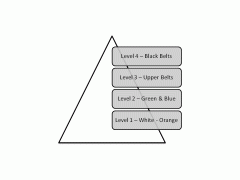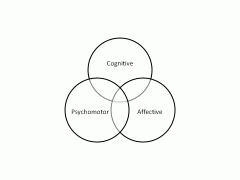![]()
![]()
![]()
Use LEFT and RIGHT arrow keys to navigate between flashcards;
Use UP and DOWN arrow keys to flip the card;
H to show hint;
A reads text to speech;
15 Cards in this Set
- Front
- Back
|
Bringing our training to higher levels |
1) consistent training 2) extra classes 3) person who is always first for class 4) give 100% during class 5) personal charts for training outside of class 6) every 'event' type of student 7) traveling student 8) read all material pertaining to the MSK training program 9) accept every fellow student of situation for the positive |
|
|
Scoring Types (Judging) |
Objective - example: power breaking - competitor either breaks or doesn't break required boards to move to the next level Subjective - involves opinion of each individual judge on many different aspects of competitor's performance like: form, harmony, grace of movement and degrees of power - examples: poomse and free sparring |
|
|
Free Sparring Judging |
Considerations: - Form of Technique - Focus of Technique - Area Struck - Power of Technique |
|
|
Corner Judging |
Corner judge can make following calls verbally: - Flag (for a "point" or "warning") - Equipment (for equipment that needs fixing) Match stopped for a call (point or warning), corner judge can make following decisions: - Point (in direction of scoring contestant) - No Point (crossing arms - negates one "for" call) - No See (hand over eyes) - Warning (same as "point") - No Warning (same as "no point") Responsibilities: any equipment that needs attending, protect competitors from injury, crowd control, assisting the center judge |
|
|
Model Concept - Domians |
Psychomotor domain - Body - includes the physical aspects of TKD study: fitness, coordination, power, balance, speed, and agility Affective domain - Spirit - development of the five tenets of MSK: indomitable spirit, self-control, perseverance, integrity, and courtesy Cognitive domain - Mind - includes thought processes, develop growing aptitude in techniques and teaching skills that the student is mastering (developing the mental aptitude required for TKD) |
|
|
Poomse Judging |
Considerations when scoring subjectively: 1) age/rank 2) ability 3) performance compared to fellow competitors 4) order in performance 5) poomse performed Outside influences: 1) judging one's own student 2) audience interference 3) style or poomse performed 4) any physical characteristics deemed desirable or not 5) other judges influence 6) fatigue from judging |
|
|
Five components of health-related physical fitness |
- muscular strength - muscular endurance - cardio-respiratory endurance - flexibility - body composition |
|
|
Lining up in the number one position |
1) lining up the class 2) bringing the class to attention 3) signaling 'bowing in' between students and instructors 4) assisting instructor before, during and after class 5) setting the top example for the class 6) signalling 'final bow' at end of class 7) making sure school is clean before and after Student is dynamic, knowledgeable and tactful |
|
|
Model Concept - Levels |
Level One - White to Orange belts - physical fitness - basic body movements - proper respect of body contact - sincere atmosphere and appreciation of fellow student Level Two - Green to blue belt - principles of movements - competition rules - history and philosophy of martial arts Level Three - Upper belts - strategies of movement (how to move with purpose) for free sparring, poomse and breaking Level Four - Black belts - program construction, methods/techniques of teaching (only the most dedicated students) |
|
|
Model Concept - Level (Diagram) |

|
|
|
Model Concept - Domains (Diagram) |

|
|
|
Red to Black |
250 credits 1 credit: class, assisting 2 credits: teaching 5 credits: demo 10 credits: tournament, presentation 15 credits: college course related to martial arts 20 credits: publication, convention, EXPO 50 credits: camp, world tour |
|
|
Balance, Stability and Mobility |
Balance: primarily physiological, but dynamic and static balance of the body are important to all. Objective focus is important for balance. Stability: degree body resists being upset or moved Enhancing stability: 1) center of gravity (COG) over base of support (BOS) 2) enlarge BOS 3) lower COG over BOS 4) quickly adjust COG over BOS 5) increase mass Mobility decreases with stability - finding the right balance |
|
|
Sparring tools and targets |
Tools (Valid points) 1) fore fist 2) foot sword 3) ball of foot 4) heel 5) instep 6) inside heel Targets (Valid points) 1) side of head gear 2) chest area 3) stomach area 4) sides |
|
|
Sparring prohibited acts |
Warnings: 1) running out of the ring 2) holding 3) stalling 4) showing back 5) pretending injury 6) ducking 7) low kick/punch 8) blind attack 9) pushing 10) intentionally falling 11) attacking unauthorized area Deduction: 1) attacking fallen opponent 2) head butting 3) throwing opponent 4) intentionally attacking unauthorized area Disqualification: 1) injuring face 2) unsportsmanlike conduct 3) attacking after "kaleo" 4) intentionally attacking unauthorized area |

